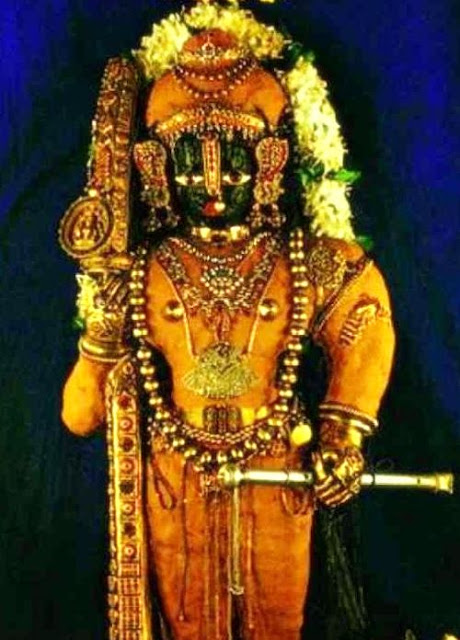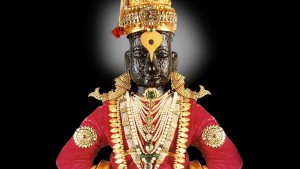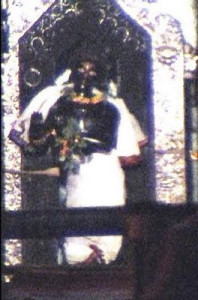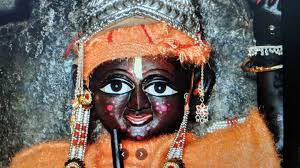Devaki and Rukmini’s Wish
At the end of Dwapara Yuga, Krishna’s mother, Devaki, and His wife, Rukmini, expressed a deep desire to witness and enjoy Krishna’s childhood pranks once more. In response to their wish, the divine architect Viswakarma created a beautiful image of Krishna, holding a churn in His right hand and a string in His left, capturing the essence of His playful childhood. Rukmini worshiped this sacred image every day with great devotion.
The Hidden Idol
After Krishna’s departure from the world, Arjuna, one of His closest companions, is believed to have hidden the idol. Over time, the image became covered with gopi chandanam, a substance similar to sandal paste. Many years later, a sailor from Dwaraka discovered this heavy lump during one of his trips along the west coast. Unaware of its divine nature, he used it as ballast for his ship. However, as the ship neared the western coast of Malpe, it was caught in a terrible storm.
Sri Madhvacharya’s Divine Intervention
At that time, Sri Madhvacharya, a revered saint and philosopher, was meditating near Malpe Beach. Through his yogic powers, Madhvacharya knew that the ship carried the sacred idols of Lord Krishna and Balarama. As the ship was on the verge of sinking, Madhvacharya intervened and saved it. In gratitude, the captain of the ship offered Madhvacharya the gopi chandanam pieces, unaware of the treasure they concealed. Madhvacharya then installed the Balarama idol at Vadabhandeshwara near Malpe Beach, while he took the Krishna idol to Udupi.
The Discovery of the Krishna Idol
According to Sri Raghuvarya Tirtha, a respected Mathadeesha (head of the monastery), the story of the Krishna idol’s installation is as follows: After the storm, the ship crashed and sank, along with its cargo, including the statue. Some days later, Sri Madhvacharya arrived in Udupi to spread his philosophy. During his meditation, he received a divine revelation and immediately traveled to Malpe with his disciples. As if guided by a new light, Madhvacharya retrieved the idol from the ocean and brought it to Udupi. He placed the idol in a pond near his monastery, known today as the Madhva Sarovar, to purify it. On Sankranti, a sacred day, Madhvacharya installed the Krishna idol in the main sanctum of his monastery, establishing it as the Krishna Mutt, which has since become one of the most revered temples in India.
The Establishment of Ashta Mathas
Sri Madhvacharya entrusted the worship and administration of Krishna Mutt to his eight primary disciples. Each disciple established a Matha (monastery) around the Krishna Mutt, known collectively as the Ashta Mathas. These Mathas—Pejavara, Puttige, Palimaru, Adamaru, Sodhe, Kaniyooru, Shirur, and Krishnapura—have managed the temple’s daily worship and administration in a cyclical order ever since. Every two years, during the Paryaya festival, the temple’s management is handed over to the next Matha. Each Matha is led by a Swami who takes charge of the temple during his Paryaya.
The Devotion of Kanakadasa In the 16th century, during the administration of Sri Vaadiraja, a devout saint named Kanakadasa arrived in Udupi to worship Lord Krishna. However, because of his lower caste, he was denied entry to the temple, as only Brahmins were permitted to offer prayers inside at that time. Determined to have darshan (a glimpse) of the Lord, Kanakadasa stood outside the temple and tried to see Krishna through a small window, but could only see the back of the Deity.
Moved by Kanakadasa’s unwavering devotion, Lord Krishna miraculously turned His form to face the window, granting Kanakadasa a direct view of His divine presence. This window is now known as “Kanakana Kindi,” and it remains a testament to the Lord’s love for His devotees. To this day, the deity of Lord Krishna in Udupi faces the back of the temple towards Kanakana Kindi, unlike most Hindu temples where the deity faces the entrance.
Lessons to be Learned
- Divine Compassion: The story of Kanakadasa teaches us that true devotion transcends all social barriers and that the Lord’s grace is available to all who seek Him with a pure heart.
- The Power of Devotion: Both Rukmini’s daily worship and Kanakadasa’s unwavering devotion highlight the transformative power of sincere devotion and prayer.
- Miraculous Intervention: The tale of Sri Madhvacharya retrieving the hidden idol demonstrates that divine intervention often comes to those who are devoted and diligent in their spiritual practice.
- Unity in Diversity: The establishment of the Ashta Mathas shows the importance of shared responsibility and unity in managing spiritual institutions.
Prayer to Udupi Krishna
O Beloved Udupi Krishna, merciful and compassionate Lord,
You who turned to bless Your devotee Kanakadasa,
Grant me the strength to hold unwavering faith in Your divine grace,
And let my heart be filled with the joy of Your presence.
May I always approach You with the simplicity and sincerity of a child,
Just as Rukmini worshiped You with love and devotion.
Guide me on the path of righteousness,
And let my life be an offering at Your lotus feet.
O Krishna, Lord of Udupi,
May Your blessings be upon all who seek You,
And may we all find refuge in Your eternal love and compassion.
Quote from Shastra
“patraṁ puṣpaṁ phalaṁ toyaṁ yo me bhaktyā prayacchati
tad ahaṁ bhakty-upahṛtam aśnāmi prayatātma-naḥ”
Translation:
“If one offers Me with love and devotion a leaf, a flower, fruit, or water, I will accept it.”
— Bhagavad Gita 9.26
This verse from the Bhagavad Gita emphasizes that Krishna accepts even the simplest offerings when made with sincere devotion, resonating with the themes of humility and devotion in the story of Udupi Krishna.



